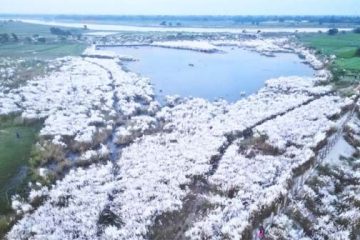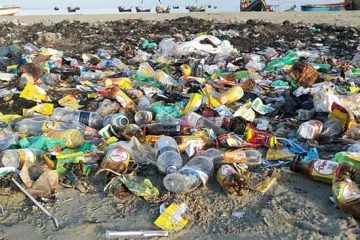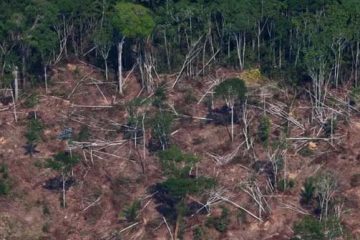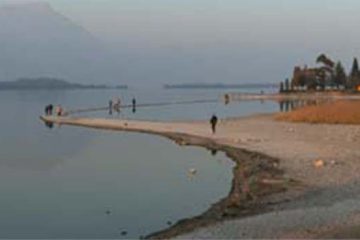Dr. Md. Mizanur Rahman
 Due to increased rate of emissions of greenhouse gases (carbon dioxide, methane, nitrous oxide, ozone and chlorofluorocarbons) from different sources such as burning of fossil fuels, deforestation and other human activities, the rate of global temperature increase accelerated from +0.6°C over the past century to an equivalent rate of +1.0°C per century in the past two decades (Natural Resource Defence Council, USA 2006). Sea-level rise as a consequence of global warming is caused by increase in seawater temperatures resulting in thermal expansion of water and melting of glacier and polar iceberg (Kennedy et. al. 2002). The climate change has already affected the ecosystems of northern hemisphere including the coastal forests.
Due to increased rate of emissions of greenhouse gases (carbon dioxide, methane, nitrous oxide, ozone and chlorofluorocarbons) from different sources such as burning of fossil fuels, deforestation and other human activities, the rate of global temperature increase accelerated from +0.6°C over the past century to an equivalent rate of +1.0°C per century in the past two decades (Natural Resource Defence Council, USA 2006). Sea-level rise as a consequence of global warming is caused by increase in seawater temperatures resulting in thermal expansion of water and melting of glacier and polar iceberg (Kennedy et. al. 2002). The climate change has already affected the ecosystems of northern hemisphere including the coastal forests.
The out flow of water from Bangladesh is the third highest in the world, next to the Amazonia and Congo basin. Major rivers of Bangladesh flow from north to south, silting up the mangroves delta and draining into the Bay of Bengal. The mangroves delta is also a region of transition between the freshwater of the rivers originating from the Ganges and the saline water of the Bay of Bengal. The ecosystems as well as the luxuriant biodiversity of Sunderbans have strong interactions with marine environments. The Sunderbans is considered as the largest single halophytic mangroves unit in the world. It has been declared as a UNESCO World Heritage Site and Ramsar Site. The environmental parameters with the direct influences on Sunderbans in terms of global climate change are sea-level rise, natural calamities like cyclones, temperature rising, salinity and drought. The structure and composition of Sunderbans may undergo major change, depending on the severity of human disturbances and predicted climate change.
The vegetation of the Sundarbans differs greatly from other non-deltaic mangroves and upland forests. It is a tropical moist forest having a mosaic pattern of old growth and successional vegetations. A total of 334 plant species were recorded in 1903 (Prain 1903). Sundari and Gewa are the dominant species throughout the old growth forests with uneven distributions of Dhundul and Kankara. Sometimes successional forests are dominated by Keora, aquatic plants and dune vegetation. There are strong correlations among vegetations, salinity, freshwater flushing, silting, inundation and mudflat accretion. Golpata, Hantol and Goran are also indicator plant species of these ecosystems.
A total number of 375 species of birds, 55 species of mammals, 83 species of reptiles and amphibians, 150 species of fish, 50 species of shrimp and other invertebrates were recorded in the Sundarbans (The Daily Star 2009). Hog deer, water buffalo, swamp deer, Javan rhinoceros, single horned rhinoceros and the mugger crocodile became extinct at the beginning of the last century. It is the paradise of eponymous Royal Bengal tiger, salt water crocodile and spotted deer. Besides, dolphins, rhesus monkey, snakes, river terrapin, forest owl, sea eagle, Indian flap-shelled turtle, peacock soft-shelled turtle, swamp partridge, trogon, ground thrush, yellow monitor, water monitor, Indian python, fishing cats, macaques, forest wagtail, wild boar, green frog, grey mongoose, scarlet minivet, fox, ring lizard, jungle cat, flying fox, pangolin, pigmy woodpecker, brown wing kingfisher, racket tailed drongo, chital and other threatened species live in the Sundarbans.
Sea level rise
One-metre rise of sea level will destroy the whole ecosystem of Sunderbans. Dune vegetation will be submerged under water. The pioneer or indicator species Sundari will be replaced by Goran and Gewa species, which are less valuable than Sundari. All ground animals will lose their habitats. Herbivorous animals like deer, monkey and wild boar will face shortage of food. Carnivorous animals like tigers and fishing cats will face the same problem due to lack of herbivorous animals in the forest. Marine turtles, crabs, shrimps, crocodiles, frogs, snakes, fresh water fishes and dolphins will lose their breeding grounds and habitat as well. The impacts of different rate of sea level rise on Sunderbans can be projected by the study of Clough (1994).
(a) Low level rise: The old growth and successional forests will be able to keep pace with a sea level rise of 8-9cm/100 years. Few species will be highly vulnerable and many species will be threatened on islands.
(b) Medium level rise: Sunderbans will be under stress, especially islands with a sea level rise of 9-12cm/100 years. A good number of species will be vulnerable and maximum species on islands will face high risk of extinction.
(c) High level rise: Sunderbans will be squeezed with a sea level rise of above 12cm/100 years. Loss of species will occur in short period of time on islands.
Storminess
There has been a noticeable change, almost 26 percent over past 120 years, in the frequency of cyclones in the Bay of Bengal, which may be increased further with the intensifying of El Nino in the upcoming days. Four disastrous cyclones originated in the Bay of Bengal since 2006 — Sidr, Nargis, Bijli and Aila. Cyclones impact Sunderbans through three primary mechanisms: wind damage, storm surge, and sedimentation. The highly affected areas will become unsuitable for habitation till 2020. Most of the inhabitants will be climate refugees with the repetition of such cyclones. Strong winds uproot, topple stems, break off trunks and defoliate the canopy. Taller stems are uprooted and knocked over when a storm ashore comes. Sediments carried by storm surges are deposited on the forest floor as the surge recedes, cause plants mortality by interfering with root and soil gas exchange, leading to eventual death of the plants. Storm surges reduce the viability of seeds, seedling germination and seedling recruitment. The recovery of forest dynamics from cyclone damage can be altered by other kinds of changes to the landscape. Many exotic plant species have the ability to rapidly colonize disturbed areas, and out-compete slower-growing native trees and plant.
These cyclones do not affect the Royal Bengal tigers too much as they can swim a long distance. But the problem is that they may lose bearing. When they do not know in which direction they have to move, they may die due to exhaustion. Strong wind destroys honey bee colonies causing high mortality. Coral reefs, woodpecker, sea turtles and parrots are vulnerable to cyclones. The arboreal monkey and lizards face shortage of foods.
Coral reefs are hit hard, fractured, and sponges and sea fans are ripped from their bases. Branching corals are broken and transported over the reef top. Dunes and beaches are washed away, and large areas completely submerged. Fish dies when the decay of foliage stripped from trees lower oxygen levels in the water. Cyclones have heavier impact on wetlands and the organisms that depend on them. Ground birds are severely affected by losing their habitats, nesting and breeding sites.
Salinity
Sunderbans is the transitional zone between freshwater supplied by rivers and saline water pushed by the Bay of Bengal. Sundari, the pioneer tree species will suffer from ‘Top dyeing’ disease with the increase of salinity. Salinity increases the tree mortality rate by reducing the production of new leaves, leaf longevity and the leaf area (Suárez and Medina, 2005). Net photosynthesis rate, stomata conductance and transpiration rate of leaves decrease with the increase of salt concentration (Yan and Guizhu, 2007). It is believed that Royal Bengal Tigers are suffering from various diseases by drinking saline water and their normal behaviour is also being changed. Aquatic organisms will migrate inward. Many fish species and other crustaceans utilize fresh water for spawning and juvenile feeding. The Hilsa needs less salinity to lay their eggs and enter various creeks in search of sweet water. The hatchlings move towards the sea where they attain adulthood, before returning to the rivers. Migration of fish species will have an adverse effect on the economy of the country.
How to combat: Some suggestions
* Designing and establishing sea-level / climate modelling network
* Establishing databases and information systems
* Data collection of Sundarbans’ resources and their uses
* Integrated coastal and marine management
* Monitoring the impact of climate change on coral reef, Royal Bengal Tiger, crocodiles and Sundari tree
* Coastal vulnerability and risk assessment
* Economic valuation of Sundarbans’ resources
* Improving catchment management
* Facilitating natural regeneration and natural succession of native tree species
* Increasing waterfront setbacks in beach front areas
* Education on climate change and emergency preparedness needs to take place at all levels by incorporating it into education curricula
* Creating public awareness through mass media
* Developing coastal infrastructure
* Initiating community based coastal forestation
* Protecting existing mangroves against encroachment and cutting
* Afforestation and reforestation by salt tolerant species
* Initiating ex-situ conservation of rare species
* Establishing mechanisms to promote carbon uptake
* Raising funds for conservation programme
* Strict control of Tigers’ poaching
(click on image to enlarge it)
Dr. Md. Mizanur Rahman is a biodiversity specialist, NDC, Jhalakathi Colloectorate e-mail: mizan_peroj@yahoo.com





